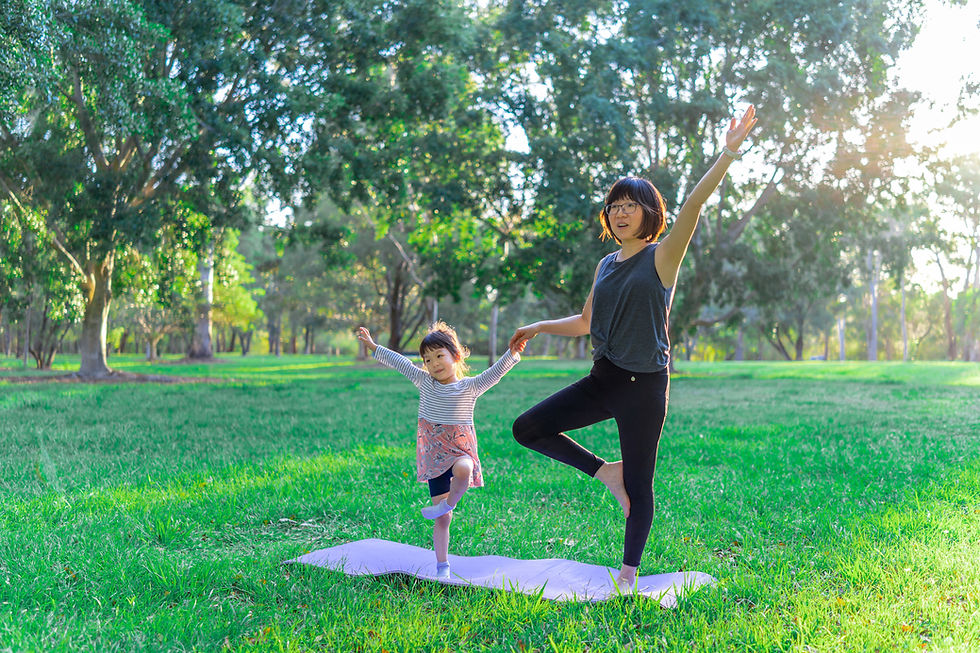Balance vs. Stability: What’s the Difference and Why It Matters
- Melanie Wintle
- Mar 30
- 3 min read

Balance and stability are often used interchangeably, but they’re not the same thing. While they work together to help you move efficiently and stay injury-free, they serve different roles in movement and control.
If you’ve ever felt unsteady on your feet or struggled with joint pain, you’ve probably heard that improving your balance can help. And while balance is important, it’s only part of the equation. Stability plays an even bigger role in keeping you moving safely and pain-free.
Here’s the simple breakdown:
Balance is your ability to stay upright and maintain control over your body’s position.
Stability is your ability to recover and maintain control when something disrupts your balance, whether it’s a sudden movement, a misstep, or even joint pain.
A Simple Analogy: The Table vs. The Yoga Ball
Think of a sturdy table with four solid legs. It doesn’t wobble or shift, it’s stable. Now, think of a yoga ball. If you sit on it, you need to constantly adjust to keep your balance.
If you had to choose which one to stand on, which would feel safer? The stable table, right?
In the same way, when your joints and muscles provide stability, movement feels more controlled and comfortable. But if your body lacks stability, you’ll feel more like that yoga ball, constantly adjusting and working hard just to stay upright, which can lead to fatigue, strain, and even injury.
Why Balance and Stability Matter for Joint and Spine Health
If you’ve been dealing with joint pain, back issues, or past injuries, improving both balance and stability can help in a few key ways:
Prevent Falls & Missteps – Many injuries happen not from big accidents but from small losses of control, like catching your foot on a step or twisting awkwardly. Stability helps you recover quickly and avoid these small but significant setbacks.
Reduce Strain on Joints – When your muscles provide good support (stability), your joints don’t have to work as hard. This can ease pain in areas like the knees, hips, and lower back.
Move with Confidence – If you feel unsteady, you might hesitate to move or exercise. Building stability allows you to move without fear, so you can stay active and independent.
Support Your Spine – Stability, especially in your core, protects your spine from excessive movement that can lead to pain or re-injury.
How to Improve Balance and Stability
The good news? You don’t need fancy equipment or extreme workouts to improve these skills.
To Improve Balance (Staying Upright & Controlled):
Heel-to-toe walking (like walking on a tightrope)
Standing on one leg (while brushing your teeth or waiting for the kettle)
Slow, controlled movements (like gentle tai chi or yoga poses)
To Improve Stability (Recovering from Unexpected Movements):
Core and hip strengthening (planks, bridges, side leg raises)
Single-leg exercises (step-ups, sit-to-stands without using hands)
Controlled resistance movements (light resistance bands for joint support)
Improve Balance and Stability, Improve Function
Balance keeps you upright. Stability helps you recover and move with control. If you’ve been struggling with joint pain or stiffness, improving both will help you move with less pain, lower your injury risk, and keep you active for years to come.
If you’re not sure where to start, I can help guide you through simple exercises that fit your current ability and daily routine. The goal isn’t to do more, it’s to move smarter, so your body works with you, not against you.
Ready to take control of your health and start living a more active life. Contact me today to learn more! Get started today
Want more tips on movement, injury prevention, and staying active as you age? Sign up for my monthly Move Well Newsletter and get evidence-based advice straight to your inbox.
References:
Muehlbauer, T., Gollhofer, A., & Granacher, U. (2015). Associations between measures of balance and lower-extremity muscle strength/power in healthy individuals across the lifespan: A systematic review and meta-analysis. Sports Medicine, 45(12), 1671-1692. https://doi.org/10.1007/s40279-015-0390-z
American Sport and Fitness. (n.d.). Balance and stability: The foundation of functional fitness. Retrieved from https://www.americansportandfitness.com/blogs/fitness-blog/balance-and-stability-the-foundation-of-functional-fitness
Disclaimer:
This site offers health, fitness and nutritional information and is designed for educational purposes only. You should not rely on this information as a substitute for, nor does it replace, professional medical advice, diagnosis, or treatment. If you have any concerns or questions about your health, you should always consult with a physician or other health-care professional. Do not disregard, avoid or delay obtaining medical or health related advice from your health-care professional because of something you may have read on this site. The use of any information provided on this site is solely at your own risk.
.png)



Comentarios